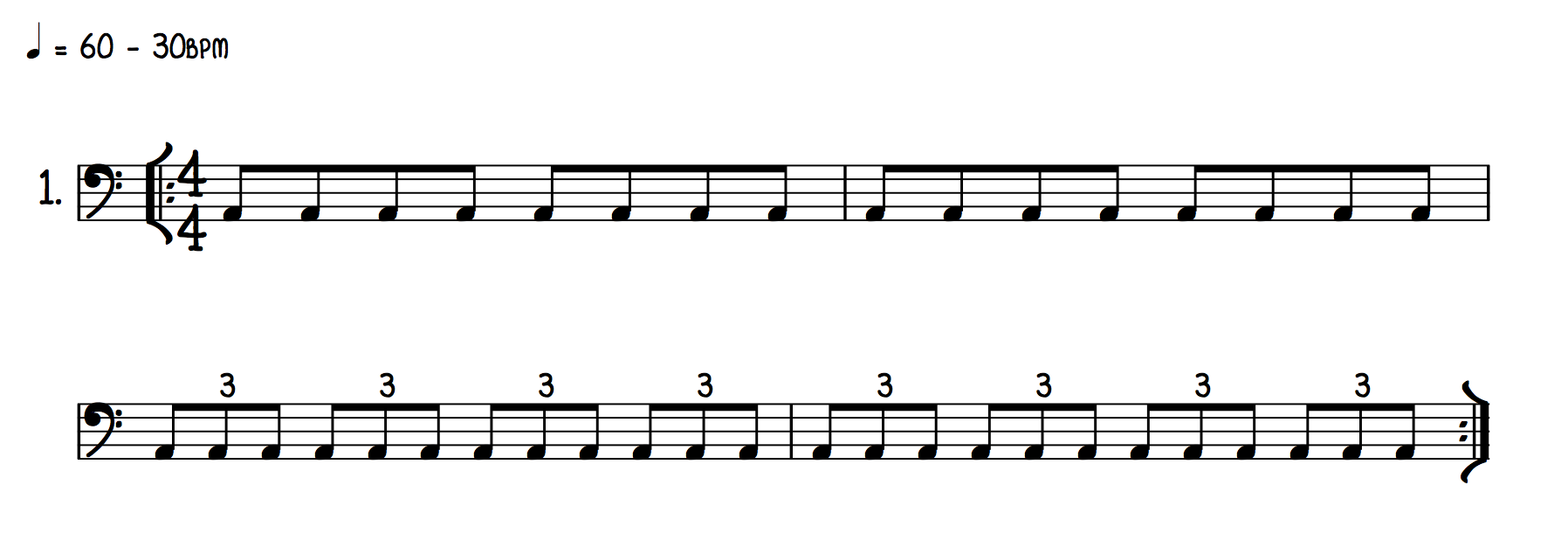Louis Bellson’s ‘Modern Reading in 4/4 Time’ is a classic educational text for drummers. I was introduced to it by one of my tutors during my first term of music college as an accompaniment to the sight reading classes I was taking; prior to starting my music degree I’d grown up almost exclusively on TAB and had never seriously read notation on the bass – needless to say, it was a rude awakening…
How Will It Benefit My Playing?
BENEFIT #1: Your sight reading skills will be transformed.
Less Sight Reading Stress
This might sound obvious, but rhythm is (in my opinion) the trickiest aspect of reading notation. Variations in pitch have relatively limited possibilities, especially as most bass lines operate within the range of an octave and we’re generally only playing one note at a time. In contrast, there is much greater scope for rhythmic variation, and bass players have to be comfortable with navigating a broad spectrum of note values. Take a look at these examples:
Example 1 – Jamiroquai ‘Runaway’
Example 2 – Me’shell Ndegeocello ‘Bittersweet’
Example 3 – Everything Everything ‘Cough Cough’
BENEFIT #2: Mastering syncopation and subdivisions will improve your groove.
A Stronger Internal Clock
One of the ways that I help students to develop their sense of time is through internal clock exercises, which use changing subdivisions to help solidify each player’s rhythmic ability.

BENEFIT #3: Your ability to process complex rhythmic ideas will improve dramatically
A Broader Rhythmic Vocabulary
Once you’re confident with reading rhythmically complex ideas then these concepts will filter through into your ‘everyday’ bass playing, both in composition and improvisation. Becoming familiar with a range of rhythmic possibilities on paper also improves your ability to hear and reproduce those ideas when playing with other musicians.
BENEFIT #4: Improving your rhythm reading will make transcribing rhythms much easier. Your ability to write music is heavily dependent on your reading ability.
More Accurate Transcriptions
The ability to hear a rhythmic phrase and visualise how it looks on paper is an essential part of the transcription process, and many bass parts have limited melodic content but are rhythmically complex. My basic training with Bellson allows me to quickly and accurately notate rhythmic information, which is a lifesaver when I have to transcribe a lot of tunes for a gig in a short amount of time.
Do you have a favourite instructional book? Tell me about it!
I’m always interested to hear about different methods that have helped people develop musically. If there’s a book that you love and feel deserves a wider audience then let me know by commenting on this post.





Reblogged this on Ugly Bass Face and commented:
This is the third of a series of posts from Tom Kenrick’s blog about unique books that many bassists would not have considered for study. On Amazon, this one is billed as being for “all instruments”, but the blog says its for drummers and the description on Amazon says, “This book has become a classic in all musicians’ libraries for rhythmic analysis and study. Designed to teach syncopation within 4/4 time, the exercises also develop speed and accuracy in sight-reading with uncommon rhythmic figures. A must for all musicians, especially percussionists interested in syncopation.” Reviewers there speak highly of it for improving sight reading, phrasing and time-keeping.